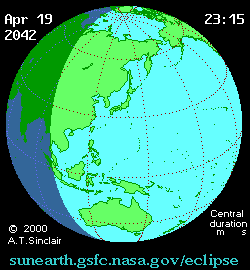| Total eclipse | |
| Gamma | 0.2956 |
|---|---|
| Magnitude | 1.0614 |
| Maximum eclipse | |
| Duration | 291 s (4 min 51 s) |
| Coordinates | 27°00′N137°18′E / 27°N 137.3°E |
| Max. width of band | 210 km (130 mi) |
| Times (UTC) | |
| Greatest eclipse | 2:17:30 |
| References | |
| Saros | 139 (31 of 71) |
| Catalog # (SE5000) | 9601 |
A total solar eclipse will occur at the Moon's ascending node of orbit between Saturday, April 19 and Sunday, April 20, 2042, [1] with a magnitude of 1.0614. A solar eclipse occurs when the Moon passes between Earth and the Sun, thereby totally or partly obscuring the image of the Sun for a viewer on Earth. A total solar eclipse occurs when the Moon's apparent diameter is larger than the Sun's, blocking all direct sunlight, turning day into darkness. Totality occurs in a narrow path across Earth's surface, with the partial solar eclipse visible over a surrounding region thousands of kilometres wide. Occurring about 21 hours after perigee (on April 19, 2042, at 5:25 UTC), the Moon's apparent diameter will be larger. [2]
Contents
- Images
- Eclipse timing
- Places experiencing total eclipse
- Places experiencing partial eclipse
- Eclipse details
- Eclipse season
- Related eclipses
- Eclipses in 2042
- Metonic
- Tzolkinex
- Half-Saros
- Tritos
- Solar Saros 139
- Inex
- Triad
- Solar eclipses of 2040–2043
- Saros 139
- Metonic series
- Tritos series
- Inex series
- Notes
- References
- External links
The path of totality will be visible from parts of western Indonesia (particularly Sumatra), eastern Malaysia, Brunei and the Philippines. A partial solar eclipse will be visible for parts of South Asia, Southeast Asia, northern Australia, East Asia, Northeast Asia, Hawaii, and northwestern North America.







































































































